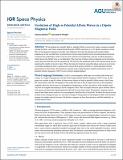Files in this item
Evolution of high-m poloidal Alfvén waves in a dipole magnetic field
Item metadata
| dc.contributor.author | Elsden, Thomas | |
| dc.contributor.author | Wright, Andrew | |
| dc.date.accessioned | 2021-02-19T00:36:19Z | |
| dc.date.available | 2021-02-19T00:36:19Z | |
| dc.date.issued | 2020-08 | |
| dc.identifier | 270051414 | |
| dc.identifier | 4a9e6c18-a91e-4748-943c-edc07deb9f71 | |
| dc.identifier | 85089889289 | |
| dc.identifier | 000577125000069 | |
| dc.identifier.citation | Elsden , T & Wright , A 2020 , ' Evolution of high-m poloidal Alfvén waves in a dipole magnetic field ' , Journal of Geophysical Research: Space Physics , vol. 125 , no. 8 , e2020JA028187 . https://doi.org/10.1029/2020JA028187 | en |
| dc.identifier.issn | 2169-9380 | |
| dc.identifier.other | ORCID: /0000-0002-9877-1457/work/80257617 | |
| dc.identifier.other | ORCID: /0000-0002-1910-2010/work/80257965 | |
| dc.identifier.uri | https://hdl.handle.net/10023/21457 | |
| dc.description | Funding: Leverhulme Trust. Grant Number: ECF‐2019‐155; UKRI Science and Technology Facilities Council (STFC) Grant Number: ST/N000609/1. | en |
| dc.description.abstract | We investigate how initially high-m, poloidal Alfvén waves evolve using a numerical model solving the ideal, cold, linear magnetohydrodynamic (MHD) equations in a 2-D dipole coordinate system. The curved magnetic geometry provides a key difference between the poloidal and toroidal Alfvén frequencies of any one field line. A polarization rotation from poloidal toward toroidal predicted from the Cartesian box model theory still occurs but now with the waves following contours of Alfvén frequency, which moves the Alfvén wave across field lines. The structure of these contours depends on the harmonic mode along the field line and the equilibrium. We find that the amplitude peak of the poloidal mode moves significantly radially outward in time. When the typically observed azimuthal phase motion of such waves is included, hodograms show a polarization rotation from purely poloidal to a mixed poloidal/toroidal polarization at all locations. Such features could be used to help interpret satellite observations of Pc4-5 poloidal ultralow frequency (ULF) waves in Earth's magnetosphere. | |
| dc.format.extent | 10482993 | |
| dc.language.iso | eng | |
| dc.relation.ispartof | Journal of Geophysical Research: Space Physics | en |
| dc.subject | Alfven waves | en |
| dc.subject | high-m | en |
| dc.subject | magnetosphere | en |
| dc.subject | MHD | en |
| dc.subject | simulation | en |
| dc.subject | ULF waves | en |
| dc.subject | GE Environmental Sciences | en |
| dc.subject | QB Astronomy | en |
| dc.subject | QC Physics | en |
| dc.subject | Aquatic Science | en |
| dc.subject | Forestry | en |
| dc.subject | Soil Science | en |
| dc.subject | Geophysics | en |
| dc.subject | Oceanography | en |
| dc.subject | Ecology | en |
| dc.subject | Water Science and Technology | en |
| dc.subject | Atmospheric Science | en |
| dc.subject | Geochemistry and Petrology | en |
| dc.subject | Earth-Surface Processes | en |
| dc.subject | Earth and Planetary Sciences (miscellaneous) | en |
| dc.subject | Palaeontology | en |
| dc.subject | Space and Planetary Science | en |
| dc.subject | DAS | en |
| dc.subject.lcc | GE | en |
| dc.subject.lcc | QB | en |
| dc.subject.lcc | QC | en |
| dc.title | Evolution of high-m poloidal Alfvén waves in a dipole magnetic field | en |
| dc.type | Journal article | en |
| dc.contributor.sponsor | Science & Technology Facilities Council | en |
| dc.contributor.institution | University of St Andrews. School of Physics and Astronomy | en |
| dc.contributor.institution | University of St Andrews. Applied Mathematics | en |
| dc.identifier.doi | 10.1029/2020JA028187 | |
| dc.description.status | Peer reviewed | en |
| dc.date.embargoedUntil | 2021-02-19 | |
| dc.identifier.grantnumber | ST/N000609/1 | en |
This item appears in the following Collection(s)
Items in the St Andrews Research Repository are protected by copyright, with all rights reserved, unless otherwise indicated.

